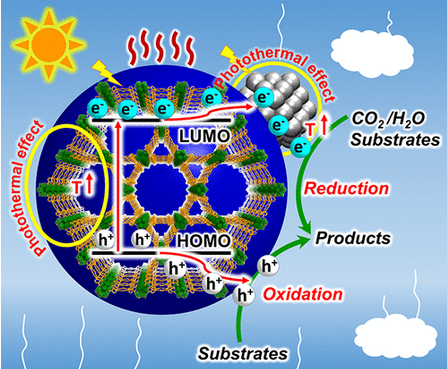
hotline:
17715390137
Tel/Wechat:
18101240246 (Technology)
0512-68565571
Email:mxenes@163.com (Sales Engineer)bkxc.bonnie@gmail.com
Scan the code to follow or search the official account on WeChat:
2D Materials Fronrier After paying attention,
click on the lower right corner to contact us,
Enter enterprise WeChat.
Professional Services Online

已传文件:photo/201984171248903.png
To meet the ever-increasing global demand for energy, conversion of solar energy to chemical/thermal energy is very promising. Light-mediated catalysis, including photocatalysis (organic transformations, water splitting, CO2 reduction, etc.) and photothermal catalysis play key roles in solar to chemical/thermal energy conversion via the light–matter interaction. The major challenges in traditional semiconductor photocatalysts include insufficient sunlight utilization, charge carrier recombination, limited exposure of active sites, and particularly the difficulty of understanding the structure–activity relationship. Metal–organic frameworks (MOFs), featuring semiconductor-like behavior, have recently captured broad interest toward photocatalysis and photothermal catalysis because of their well-defined and tailorable porous structures, high surface areas, etc. These advantages are beneficial for rational structural modulation for improved light harvesting and charge separation as well as other effects, greatly helping to address the aforementioned challenges and especially facilitating the establishment of the structure–activity relationship. Therefore, it is increasingly important to summarize this research field and provide in-depth insight into MOF-based photocatalysis and photothermal catalysis to accelerate the future development.
In this Account, we have summarized the recent advances in these two directly relevant applications, photocatalysis and photothermal catalysis, mainly focusing on the results in our lab. Given the unique structural features of MOFs, we have put an emphasis on rational material design to optimize the components and performance and to understand related mechanisms behind the enhanced activity. This Account starts by presenting an overview of solar energy conversion by catalysis. We explain why MOFs can be promising photocatalysts and exemplify the semiconductor-like behavior of MOFs. More importantly, we show that MOFs provide a powerful platform to study photocatalysis, in which the involved three key processes, namely, light harvesting, electron–hole separation, and surface redox reactions, can be rationally improved. Meanwhile, the structure–activity relationship and charge separation dynamics are illustrated in this part. In addition, MOFs for photothermal catalysis have been introduced that are based on the photothermal effect of plasmonic metals and/or MOFs, together with light-driven electronic state optimization of active sites, toward enhanced heterogeneous organic reactions. Finally, our brief outlooks on the current challenges and future development of MOF photocatalysis and photothermal catalysis are provided. It is believed that this Account will afford significant understanding and inspirations toward solar energy conversion over MOF-based catalysts.
Doi: 10.1021/acs.accounts.8b00521
下载链接:https://pubs.acs.org/doi/10.1021/acs.accounts.8b00521


| Reminder: Beijing Beike New Material Technology Co., Ltd. supplies products only for scientific research, not for humans |
| All rights reserved © 2019 beijing beike new material Technology Co., Ltd 京ICP备16054715-2号 |